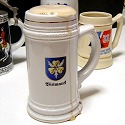
Report of the Commander in Chief, Navy, to the Führer on 13 April 1940 in the afternoon.
(The Chief of the OKW [Generaloberst Keitel] was not present.)
1. Submarines as transports.
a. The following have departed:
c. Of the boats not yet completed, six can be converted according to the Führer's order: U123, U124, U103, U104, U105, and U106.
The boats should be ready during the months of May to September; their completion can be speeded up by simplifying fire control equipment, etc.
In reply to a question on my part, the statement is made that the boats which are now needed are to be used only for shuttle traffic between Trondheim and Narvik or Bergen and Trondheim, and their radius of action should be adjusted accordingly.
2. Battleship operation.
Up to now there has been no report on the course of yesterday's engagement.
The plane (piloted by Oberleutnant zur See Quaet-Faslem) was catapulted from the SCHARNHORST in order to take a radio message, which the Fleet Commander sent to the HIPPER, to Trondheim for transmission to Group West.
It returned from Trondheim to Wilhelmshaven, where Oberleutnant zur See Quaet-Faslem merely reported his impressions of the engagement off the Lofoten Islands.
Today, 13 April, at 1000 the Fleet Commander gave a short report to the Commander in Chief, Navy, by telephone on the tactical situation during the engagement, and his views regarding the break-through.
The Commander in Chief, Navy, fully endorses the conduct of the Fleet Commander.
It would have been wrong to have all-out battleship operations off the Lofoten Islands; the tactical situation was very unfavorable, with the enemy disposed along the dark western horizon, our ships along the clear eastern horizon, and the wind strength 10.
3. The situation on the Norwegian coast is discussed.
4. Our own measures.
The mine field in the Skagerrak was reinforced to the north and south during the night of 12 April.
Beginning today, submarines will be distributed as follows:
6. The LÜTZOW was ordered to Kiel to be prepared as quickly as possible for Atlantic operations.
Her presence in the Atlantic would have diverted naval forces from the North Sea, among others aircraft carriers and large cruisers.
It is hoped that the two auxiliary cruisers "16" [Atlantis] and "36" [Orion] will have this effect; they probably have just broken through into the Atlantic.
7. Political questions:
b. The Swedes have extinguished all beacon lights, even the large outer lights.
May pressure be brought to bear to leave the beacons lit? Führer: Yes; through the Foreign Office.
9. Role of the Navy in landing operations. There are doubts regarding the accuracy of the reports on hits made by the Air Force, although submitted in good faith.
The greater proportion of the large ships reported hit are still operating in the North Sea.
The operations of our two battleships have to be planned with this in view.
They will be made ready as quickly as possible.
10. Landing operations were begun two days too late; the Commander in Chief, Navy always insisted on 7 April as being the best X day.
Since the British got ahead of us by laying mines, and the Norwegian attitude stiffened (pilots, etc.), it was impossible to bring supply vessels north in time.
|
 BOOK: The Battleship Bismarck. The Complete History of the Ship.
 Naval & military gifts
|
